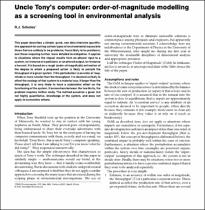 ResearchSpace
ResearchSpace
Uncle Tony's computer: order-of-magnitude modelling as a screening tool in environmental analysis
JavaScript is disabled for your browser. Some features of this site may not work without it.
- ResearchSpace
- →
- Research Publications/Outputs
- →
- Journal Articles
- →
- View Item
| dc.contributor.author |
Scholes, RJ

|
|
| dc.date.accessioned | 2007-06-29T07:50:21Z | |
| dc.date.available | 2007-06-29T07:50:21Z | |
| dc.date.issued | 2002-09 | |
| dc.identifier.citation | Scholes, RJ. 2002. Uncle Tony's computer: order-of-magnitude modelling as a screening tool in environmental analysis. South African Journal of Science, vol. 98, 10 September, pp 494-496 | en |
| dc.identifier.issn | 0038-2353 | |
| dc.identifier.uri | http://hdl.handle.net/10204/751 | |
| dc.description | Copyright: 2002 Academy of Science of South Africa | en |
| dc.description.abstract | This paper describes a simple, quick, non data-intensive quantitative approach for sorting certain types of environmental issues into those that are unlikely to be problems; those likely to be problems; and those requiring further, more detailed investigation. It applies to situations where the impact results from an altered input to a system, for instance of a pollutant, or an altered output, for instance a harvest. It is based on a rough (order-of-magnitude) estimation of the degree to which a proposed action is likely to perturb the throughput of a given system. If the perturbation is an order of magnitude or smaller than the throughput, it is deemed unlikely to affect the ecology of that system in a material way. If larger than the throughput, it is very likely to have a substantial effect on the functioning of the system. If somewhere between the two limits, the problem requires further study. The method assumes a good, but not highly quantitative, knowledge of the system, and does not apply to cumulative effects. | en |
| dc.language.iso | en | en |
| dc.publisher | Academy of Science of South Africa | en |
| dc.subject | Environmental analysis | en |
| dc.subject | Uncle Tony's computer | en |
| dc.subject | Screening tools | en |
| dc.subject | Order of magnitude | en |
| dc.title | Uncle Tony's computer: order-of-magnitude modelling as a screening tool in environmental analysis | en |
| dc.type | Article | en |
| dc.identifier.apacitation | Scholes, R. (2002). Uncle Tony's computer: order-of-magnitude modelling as a screening tool in environmental analysis. http://hdl.handle.net/10204/751 | en_ZA |
| dc.identifier.chicagocitation | Scholes, RJ "Uncle Tony's computer: order-of-magnitude modelling as a screening tool in environmental analysis." (2002) http://hdl.handle.net/10204/751 | en_ZA |
| dc.identifier.vancouvercitation | Scholes R. Uncle Tony's computer: order-of-magnitude modelling as a screening tool in environmental analysis. 2002; http://hdl.handle.net/10204/751. | en_ZA |
| dc.identifier.ris | TY - Article AU - Scholes, RJ AB - This paper describes a simple, quick, non data-intensive quantitative approach for sorting certain types of environmental issues into those that are unlikely to be problems; those likely to be problems; and those requiring further, more detailed investigation. It applies to situations where the impact results from an altered input to a system, for instance of a pollutant, or an altered output, for instance a harvest. It is based on a rough (order-of-magnitude) estimation of the degree to which a proposed action is likely to perturb the throughput of a given system. If the perturbation is an order of magnitude or smaller than the throughput, it is deemed unlikely to affect the ecology of that system in a material way. If larger than the throughput, it is very likely to have a substantial effect on the functioning of the system. If somewhere between the two limits, the problem requires further study. The method assumes a good, but not highly quantitative, knowledge of the system, and does not apply to cumulative effects. DA - 2002-09 DB - ResearchSpace DP - CSIR KW - Environmental analysis KW - Uncle Tony's computer KW - Screening tools KW - Order of magnitude LK - https://researchspace.csir.co.za PY - 2002 SM - 0038-2353 T1 - Uncle Tony's computer: order-of-magnitude modelling as a screening tool in environmental analysis TI - Uncle Tony's computer: order-of-magnitude modelling as a screening tool in environmental analysis UR - http://hdl.handle.net/10204/751 ER - | en_ZA |





